European Neighbourhood Policy - East - economic statistics
Data extracted in March 2023.
Planned article update: April 2024.
Highlights
In 2021, the gross domestic product (GDP), a standard measure of economic output, of the European Neighbourhood Policy-East countries was equivalent to 1.7 % of that of the EU.
GDP per person was between 12 % and 14 % of that in the EU in each of the European Neighbourhood Policy-East countries in 2021.
Of the European Neighbourhood Policy-East countries for which data was available, Ukraine had the highest foreign direct investment (FDI) inflow in 2021. However, FDI inflow relative to GDP was greatest in Georgia.
Real GDP growth, 2011-2021
This article is part of an online publication. It presents statistics on recent economic developments for five European Neighbourhood Policy-East (ENP-East) countries, namely, Armenia, Azerbaijan, Georgia, Moldova and Ukraine, compared with the European Union (EU). Georgia, Moldova and Ukraine also all became enlargement countries in 2022, the European Council giving the three a European perspective and granting Moldova and Ukraine candidate status on 23 June 2022. This article does not contain any data on Belarus, as statistical cooperation with Belarus has been suspended as from March 2022.
Data shown for Georgia exclude the regions of Abkhazia and South Ossetia over which Georgia does not exercise control. The data managed by the National Bureau of Statistics of the Republic of Moldova does not include data from Transnistria over which the government of the Republic of Moldova does not exercise control. Since 2014, data for Ukraine generally exclude the illegally annexed Autonomous Republic of Crimea and the City of Sevastopol and the territories which are not under control of the Ukrainian government. The latest statistics in this Statistics Explained article cover the calendar year 2021, before Russia’s invasion of Ukraine. Data on Ukraine for the year 2021 is limited due to exemption under the martial law from mandatory data submission to the State Statistics Service of Ukraine, effective as of 3 March 2022.
This article presents, among others, statistics on gross domestic product (GDP) per capita; the composition of gross value added; government finance statistics (on the general government deficit and general government consolidated gross debt relative to GDP); the balance of payments with the rest of the world; and foreign direct investment (FDI). These statistics are among the core indicators used for monitoring economic developments and informing government economic policy.
Full article
Gross domestic product (GDP)
Gross domestic product (GDP) is an aggregate measure of the size of an economy, based on its total final output. As shown in Table 1, the ENP-East countries had a combined GDP of €254 billion in 2021. In comparison, the GDP of the EU was €14.5 trillion.
In 2021, the largest economy among the ENP-East countries was Ukraine, with its GDP provisionally valued at €169 billion. The economy of Azerbaijan had GDP of €46 billion. The other ENP-East economies were much smaller: Georgia’s economy was provisionally valued at €16 billion, 9 % the size of that in Ukraine. GDP in Armenia and Moldova (provisional data) were each valued at €12 billion in 2021.
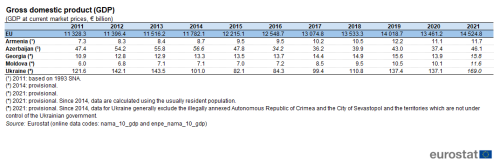
(GDP at current market prices, € billion)
Source: Eurostat (nama_10_gdp) and (enpe_nama_10_gdp)
Analysis of GDP per capita (per person) removes the influence of the population size, making comparisons between different countries easier. As a result, GDP per capita is a broad economic indicator that may be used for a basic analysis of living standards.
As shown in Figure 1, in 2021 the highest GDP per capita among the ENP-East countries was recorded in Azerbaijan, at €4 600 per inhabitant. In Moldova, GDP per capita was measured at €4 400 per inhabitant; in Georgia, at €4 200; in Ukraine, €4 100 per inhabitant; and in Armenia, €4 000 per inhabitant. Except Armenia and Azerbaijan, all data is provisional.
Differences in GDP per capita between the ENP-East countries were limited – they are more similar than the EU Member States in this respect. GDP per capita in the EU averaged €32 400 in 2021, which was between seven and eight times higher than in the ENP-East countries.
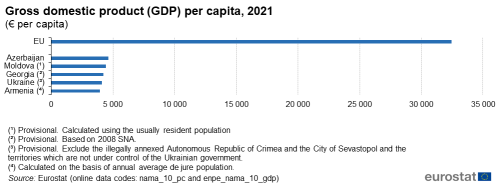
(€ per capita)
Source: Eurostat (enpe_nama_10_gdp) and (nama_10_pc)
Real GDP, also called GDP at constant prices, focuses on the volume of output, ignoring price changes. The calculation of the annual growth rate of GDP at constant prices, in other words the real change in GDP, allows comparison of the dynamics of economic development, both over time and between economies of different sizes, regardless of price developments.
Data on annual change in real GDP are shown in Table 2 and in the highlights graphic for the period 2011-2021. Over the period 2011 to 2019, immediately before the 2020 pandemic, average annual rates of growth were faster in some ENP-East countries than in the EU: 4.7 % in Armenia and Georgia and 3.9 % in Moldova. In Azerbaijan, the effect of the global oil price fall in 2016 led to a substantial decrease in GDP of -3.1 % in that year and an overall growth rate over the 2011-2019 period of 1.5 %. In Ukraine, there was minimal average annual growth rate of 0.1 % over this period, which included the illegal Russian annexation of the Autonomous Republic of Crimea and the City of Sevastopol in 2014 and loss of government control over further territories. In the EU, annual average growth in constant price GDP over 2011-2019 was 1.5 %.
The year 2020 marked the start of the economic impact of the Covid-19 pandemic. All ENP-East countries and the EU recorded a decline in real GDP in that year. Among the ENP-East countries, the largest decline was in Moldova at -8.3 %, followed by Armenia at -7.2 % and Georgia at -6.8 %. The decline in Azerbaijan was -4.2 % and in Ukraine, -3.8 %. The decline in the EU was -5.6 %.
The difference between the real change in GDP for 2020 and the average growth rate from 2011 to 2019 illustrates the size of the 2020 economic impact. The greatest negative impact was noted in Moldova, at -12.2 percentage points (pp), followed by Armenia at -11.9 pp Georgia at -11.5 pp. The impact in Azerbaijan was -5.7 pp and in Ukraine -3.9 pp. In the EU, the economic impact was -7.1 pp.
Although the Covid-19 pandemic continued in 2021, the economies of the ENP- East countries and the EU rebounded. This was also the last year before Russia’s invasion of Ukraine. Generally, the countries that suffered the largest economic impact in 2020 also showed the greatest recovery. Most of these countries recorded a larger growth in 2021 than the corresponding contraction in 2020. Hence, Moldova’s real GDP growth in 2021 was 13.9 %, Georgia’s 10.4 % and Azerbaijan’s 5.6 %, all greater than the decline in real GDP in 2020. The exceptions were Armenia, where the 5.7 % growth in real GDP in 2021 fell 1.5 pp short of compensating the decline in 2020, and Ukraine with 3.4 % (0.4 pp less than the corresponding fall in 2020). All ENP- East data for 2021 is provisional, except Azerbaijan. In the EU, constant price GDP growth in 2021 was 5.4 %.
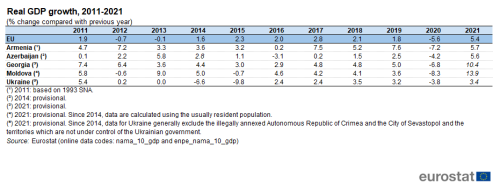
(% change compared with previous year)
Source: Eurostat (enpe_nama_10_gdp) and (nama_10_gdp)
Gross value added by economic activity
Analysis of the gross value added by economic activity is useful to illustrate the changes in the structure of an economy over time. The analysis is limited by the fact that the ‘services’ category itself contains a wide variety of activities, such as government, transport services, tourism and business services. The proportion of construction in an economy typically varies over the cycle, with the sector doing well in periods of high growth and often contracting during recessions. The data are shown in Figure 2 for 2011 and 2021. All ENP-East data for 2021 is provisional, except Azerbaijan.
In 2021, the share of agriculture, forestry and fishing was considerably greater in the ENP-East countries than it was in the EU, where it accounted for only 1.8 % of total value added. Among the ENP-East countries, the shares of this economic activity in 2021 ranged from 6.4 % in Azerbaijan to 12.4 % in Ukraine and 12.5 % in Armenia.
The lowest shares of industry among the ENP-East countries in 2021 were 14.5 % in Moldova and 17.0 % in Georgia, while the highest was 46.5 % in Azerbaijan, with its large petroleum sector. In the EU, for comparison, industry accounted for 19.9 % of gross value added in 2021. The lowest share of services in the ENP-East economies was 40.7 % in Azerbaijan and the highest was 68.0 % in Georgia. In the EU in 2021, the share of services was 72.7 %.
The structure of Georgia’s economy stayed relatively stable between 2011 and 2021, the largest changes being an increase of 2.8 percentage points (pp) in the share of construction, an increase of 2.0 pp for industry but a decrease of -3.3 pp for agriculture, forestry and fishing. The share of agriculture, forestry and fishing in Ukraine’s economy grew by 3.0 pp over this period, while that of services fell by -1.6 pp and that of industry by -1.0 pp. The share of construction in Moldova’s economy increased by 1.9 pp and that of services by 1.5 pp, while the share of industry fell by -2.2 pp and the share of agriculture, forestry and fishing by -1.2 pp between 2011 and 2021. Armenia appears to have experienced considerable structural change in this period, with the share of services growing by 13.2 pp and that of industry by 3.5 pp, while the share of agriculture, forestry and fishing fell by -9.7 pp and that of construction by -7.0 pp. In Azerbaijan, services increased their share of the economy from 2011 to 2021 by 11.6 pp, while industry’s share fell by an approximately corresponding -10.6 pp.
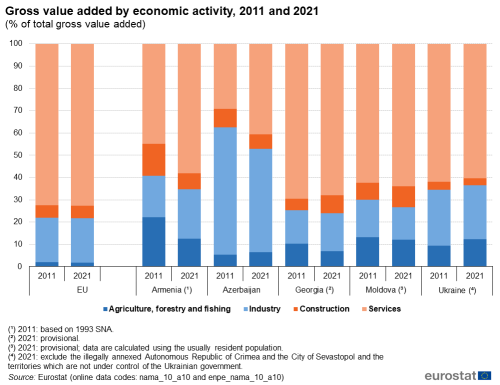
(% of total gross value added)
Source: Eurostat (enpe_nama_10_a10) and (nama_10_a10)
General government deficit and debt
The general government deficit or surplus as a percentage of GDP measures the difference between government expenditure and receipts in each year, relative to the size of the economy. If the deficit is greater than the economy’s growth rate, then the country’s government debt, the stock of past deficits and surpluses, increases relative to the size of the economy. A heavy debt burden may mean that a large proportion of government receipts are allocated to interest payments. Many governments attempt to run a small deficit or a surplus in good economic periods, while allowing larger deficits in times of recession or crisis. The surplus/deficit data are illustrated in Figure 3 and those for debt in Figure 4. These two figures should be read together.
Over the period 2011-2019, the average deficits in all ENP-East countries and in the EU were smaller than they were in 2020, the year that the Covid-19 pandemic first affected government finances. The average deficits over the period 2011-2019 ranged from -2.8 % of GDP in Armenia to -0.3 % in Azerbaijan. In the EU, the average government deficit was -2.0 % of GDP. In 2020, government deficits ranged from -9.3 % in Georgia to -2.4 % of GDP in Azerbaijan, while it was -6.7 % of GDP in the EU.
In the year 2021, government finances partially rebounded, with Georgia running the deepest deficit in the ENP-East region at -6.3 % of GDP, while Moldova ran a balanced budget (no surplus or deficit). For comparison, the EU ran a deficit of -4.6 % of GDP in 2021. With the exception of Moldova, all ENP-East countries, as well as the EU, ran deeper government deficits in 2021 than they had in 2019, as the balance of government expenditure against receipts continued to be affected by the Covid-19 pandemic.
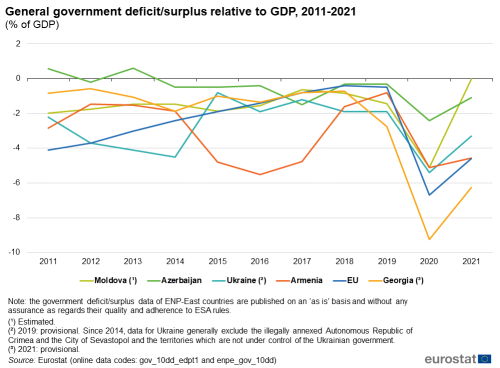
(% of GDP)
Source: Eurostat (enpe_gov_10dd) and (gov_10dd_edpt1)
Debt-to-GDP ratios, shown in Figure 4, increased in all ENP-East countries over the period 2011-2019 (no data available for Azerbaijan), 2019 being the last year before the Covid-19 pandemic affected both GDP and debt levels. The largest change occurred in Ukraine, where the ratio widened by 45.8 pp from 35.1 % of GDP in 2011 to 80.9 % in 2016. It should be kept in mind that the illegal Russian annexation of the Autonomous Republic of Crimea and the City of Sevastopol in 2014 and the loss of government control over further territories fell within this period, leading to sharp falls in the GDP of Ukraine in both 2014 and 2015. From this peak in 2016, Ukraine’s debt-to-GDP ratio diminished to 50.2 % in 2019. Over the whole period 2011-2019, the debt ratio deteriorated by 15.1 pp.
Among the other ENP-East countries, government debt relative to GDP in Armenia moved from 37.4 % of GDP in 2011 to 50.2 % in 2019, worsening by 12.8 pp. Government debt was recorded at 31.0 % of Georgia’s GDP in 2011 and 41.8 % in 2019, a deterioration of 10.8 pp over this period. Moldova’s government debt in 2011 was 19.7 % of GDP and 25.1 % in 2019, an increase in the government debt burden relative to GDP of 5.4 pp. The EU’s government debt was much larger as a percentage of GDP: 81.8 % in 2011 and 77.5 % in 2019, a reduction in the relative debt burden of 4.3 pp.
The data show an increase in government debt in 2020 in all ENP-East countries and the EU, affected by the economic effects of the pandemic. Of greater interest is to compare this last year prior to the pandemic, 2019, with 2021. This shows how the initial stages of recovery are reflected in the government debt statistics. Armenia’s government debt relative to GDP deteriorated by 16.1 pp from 2019 to 2021, to 66.3 % of GDP in 2021. Over this period, Georgia’s debt ratio widened by 7.6 pp to a provisional 49.4 % of GDP. Similarly, Moldova’s debt ratio grew by 7.5 pp to 32.6 % of GDP. Ukraine’s debt as a percentage of GDP improved by 1.3 pp over 2019-2021, falling then to 48.9 % in 2021. In the EU, government debt in 2021 was equivalent to 87.9 % of GDP, representing an increase of 10.4 pp from 2019.
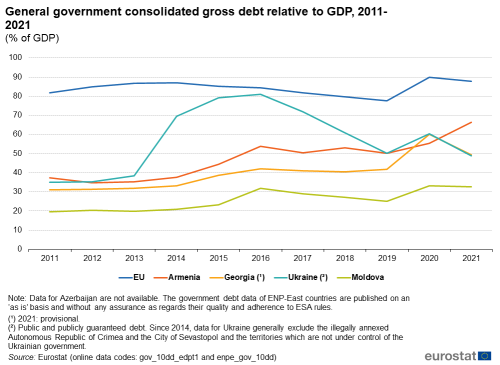
(% of GDP)
Source: Eurostat (enpe_gov_10dd) and (gov_10dd_edpt1)
Balance of Payments
The current account of the balance of payments represents transactions with the rest of the world concerning merchandise trade, services, factor income and other current transfers. It is normal for countries that are very fast growing to run negative balances, which represent borrowing from the rest of the world. Developed countries often run surpluses, which represent building up assets in the rest of the world. A balance of payments deficit that is consistently large compared with the country’s GDP can lead to financial difficulties. Data for the ENP-East countries and the EU is illustrated by Figure 5.
Three of the ENP-East countries reduced their balance of payments deficits during the period 2011-2021. In Armenia the deficit was 10.4 % of GDP in 2011 and 3.7 % in 2021, an improvement of 6.7 pp. In Georgia, the deficit was reduced by 1.8 pp from 12.2 % of GDP in 2011 to 10.4 % in 2021.
Ukraine’s deficit was 6.0 % of GDP in 2011, improving by 4.4 pp to a deficit of 1.7 % in 2021. However, Ukraine’s economy fluctuated strongly within this period. Following a substantial fall in exports to Russia in 2013, the illegal annexation of Crimea and Sevastopol by the Russian Federation in 2014 and the loss of government control in areas of Donetsk and Luhansk oblasts the same year, Ukraine’s GDP and current account fell sharply, as did foreign investments in the Ukrainian economy. Following the decision in 2014 to implement a floating exchange rate, the hryvna depreciated strongly in 2014 and 2015. A number of economic measures were undertaken in this period, and the International Monetary Fund (IMF) provided support subject to economic reforms. Thus, Ukraine’s balance of payments showed a net surplus of 5.5 % of GDP in 2015, against a backdrop of a substantially lower GDP (see Table 1). In comparison, there were deficits in the balance of payments in the preceding years, of -7.9 % of GDP in 2012, -8.7 % in 2013 and -3.4 % in 2014.
In Moldova, the balance of payments deficit deteriorated by 2.3 pp from 10.1 % of GDP in 2011 to 12.4 % in 2021. Azerbaijan is an outlier: its surplus was 26.0 % of GDP in 2011, declining by 10.8 pp to a surplus of 15.2 % in 2021. In 2016, it ran a deficit of 3.6 % of GDP as a consequence of a fall in the global oil price. Hydrocarbon exporting countries often run external payments surpluses when prices of oil, gas and other petroleum products are high, as a means of limiting the rise in value of their currencies and so protecting their other economic activities from becoming increasingly uncompetitive internationally. The EU’s balance of payments was in surplus by 0.6 % of GDP in 2011, rising to a maximum surplus of 3.2 % in 2016, declining to 2.4 % of GDP in 2021. From 2011 to 2021 the surplus as a percentage of GDP increased by 1.8 pp.
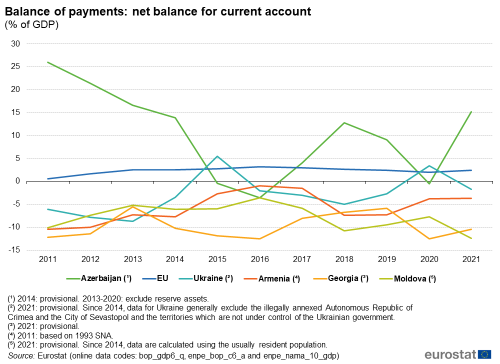
(% of GDP)
Source: Eurostat (enpe_bop_c6_a), (enpe_nama_10_gdp) and (bop_gdp6_q)
Foreign direct investment
Foreign direct investment (FDI) represents a lasting interest in an enterprise operating in another economy and implies the existence of a long-term relationship between the direct investor and the recipient enterprise. It forms a part of the financial account of the balance of payments. Inflows represent flows of investment into the economy; outflows represent flows of investment by the economy in the rest of the world. Negative values represent a reduction in the value of FDI in the economy; this may reflect transfer of ownership from foreign to domestic investors, revaluation of investments or other disinvestment. Countries that attract considerable inward investment are often themselves investors in other countries. Inward inflows of foreign direct investment are shown in Table 3; outflows are shown in Table 4. Since FDI may reflect large investments in specific projects within a limited timeframe, data values can vary greatly from one year to another.
Ukraine was the ENP-East country that received the largest absolute flows of inward FDI, at €37.1 billion in total over the period 2011-2021. Georgia’s inward FDI was €12.5 billion over the same period. Armenia received FDI of €2.8 billion and Moldova €2.5 billion over 2011-2021. Data are not available for Azerbaijan.
Relative to GDP, presented in Table 1 above, Georgia attracted the highest inward FDI as proportion of its GDP among the ENP-East countries in 2021, at 6.7 % of GDP. It was followed by Ukraine at 3.3 %, Moldova at 2.9 % and Armenia at 2.6 % of GDP. In the EU, inward FDI was -1.7 % of GDP in 2021.

(€ million)
Source: Eurostat (bop_fdi_flow_r2), (bop_fdi6_flow) and Eurostat data collection
Outward FDI by ENP-East countries was much lower than inward FDI. Data for the period 2011-2021 is shown in Table 4. Georgia’s total outward direct investment over this period was €2.5 billion, representing 19.6 % of its inward flow (from Table 3). Ukraine’s outward FDI over 2011-2021 was €2.2 billion, 6.0 % of its inward flow. Armenia’s and Moldova’s outward FDI over the period both totalled €0.2 billion, equivalent to 7.9 % and 8.2 % of their inward flows, respectively.
Over the period 2011-2021, EU’s outward FDI totalled €3 057 billion, equivalent to 116.8 % of its inward flow. Note that there was a methodological change in the EU data between 2012 and 2013.

(€ million)
Source: Eurostat (bop_fdi_flow_r2), (bop_fdi6_flow) and Eurostat data collection
Source data for tables and graphs
Data sources
The data for ENP-East countries are supplied by and under the responsibility of the national statistical authorities of each country on a voluntary basis. The data result from an annual data collection cycle that has been established by Eurostat. These statistics are available free-of-charge on Eurostat’s website, together with a range of additional indicators for ENP-East countries covering most socio-economic topics.
The European system of national and regional accounts (ESA) provides the methodology for national accounts in the EU. The data presented in this article for ENP-East countries were generally collected under ESA 2010, which is consistent with worldwide guidelines for national accounts, the 2008 SNA.
GDP is the central measure of national accounts, which summarises the economic position of a country (or region). It can be calculated using different approaches: the output approach; the expenditure approach; and the income approach. The main aggregates of national accounts are compiled from institutional units, namely non-financial or financial corporations, general government, households, and non-profit institutions serving households (NPISH).
Tables in this article use the following notation:
| Value in italics | data value is forecasted, provisional or estimated and is therefore likely to change; |
| : | not available, confidential or unreliable value; |
| – | not applicable. |
Context
Indicators derived from national accounts provide a picture of the economic situation; they are widely used for analysis and forecasting, as well as policymaking. The global financial and economic crisis reinforced the need to develop more robust national accounts and government statistics in order to improve the surveillance and monitoring of financial systems and the impact that the crisis may have on economies, while also providing additional valuable information to support economic initiatives geared towards recovery. The use of internationally accepted concepts and definitions permits analysis of different economies, such as the interdependencies between the economies of the EU Member States, or a comparison between the EU and non-member countries.
Within the EU, multilateral economic surveillance was introduced through the stability and growth pact, which provides for the coordination of fiscal policies. Economic statistics have become one of the cornerstones of global, regional and national governance, for example, to analyse national economies during the global financial and economic crisis or to put in place EU initiatives such as the European semester, designed to promote discussions concerning economic and budgetary priorities.
On 2 July 2021, the European Commission and the EU High Representative for Foreign Affairs and Security Policy presented the Eastern Partnership: a Renewed Agenda for cooperation with the EU’s Eastern partners. This agenda is based on the five long-term objectives, with resilience at its core, as defined for the future of the Eastern Partnership in the Joint Communication Eastern Partnership policy beyond 2020: Reinforcing Resilience – an Eastern Partnership that delivers for all in March 2020. It is further elaborated in the Joint Staff Working Document Recovery, resilience and reform: post 2020 Eastern Partnership priorities. It is underpinned by an Economic and Investment plan. The Joint Declaration of the Eastern Partnership Summit ‘Recovery, Resilience and Reform’ of 15 December 2021 reaffirms strong commitment to a strategic, ambitious and forward-looking Eastern Partnership.
In cooperation with its ENP partners, Eurostat has the responsibility ‘to promote and implement the use of European and internationally recognised standards and methodology for the production of statistics, necessary for developing and monitoring policy achievements in all policy areas’. Eurostat undertakes the task of coordinating EU efforts to increase the statistical capacity of the ENP countries. Additional information on the policy context of the ENP is provided here.
Direct access to
- All articles on non-EU countries
- European Neighbourhood Policy countries — statistical overview — online publication
- Statistical cooperation — online publication
Books
Factsheets
Leaflets
- Basic figures on the European Neighbourhood Policy — East countries — 2020 edition
- Basic figures on the European Neighbourhood Policy — East countries — 2019 edition
- Basic figures on the European Neighbourhood Policy — East countries — 2018 edition
- Basic figures on the European Neighbourhood Policy — East countries — 2016 edition
- Basic figures on the European Neighbourhood Policy — East countries — 2015 edition
- Basic figures on the European Neighbourhood Policy — East countries — 2014 edition
- International trade for the European Neighbourhood Policy — East countries — 2016 edition
- European Neighbourhood Policy-East countries — Statistics on living conditions — 2015 edition
- European Neighbourhood Policy — East countries — Key economic statistics — 2014 edition
- European Neighbourhood Policy — East countries — Labour market statistics — 2014 edition
- European Neighbourhood Policy — East countries — Youth statistics — 2014 edition
- Economy and finance (enpe_ecf)
- National accounts (enpe_na)
- GDP, main aggregates and economic indicators (enpe_nama_gdp)
- Gross value added by industry (enpe_nama_a10)
- Deficit/surplus and debt (enpe_gov)
- Government deficit/surplus and debt (enpe_gov_10dd)
- Balance of payments (enpe_bop)
- Balance of payments (enpe_bop_c6_a)
- National accounts (enpe_na)
- Main GDP aggregates (nama_10_ma)
- Government finance statistics (EDP and ESA2010) (gov_gfs10)
- Balance of payments - International transactions (BPM6) (bop_6)
- Balance of payments statistics and international investment positions (BPM6) (bop_q6)
- European Union and euro area balance of payments - quarterly data (BPM6) (bop_eu6_q)
- Balance of payments statistics and international investment positions (BPM6) (bop_q6)
- European Union direct investments (bop_fdi)
- EU direct investment flows, breakdown by partner country and economic activity (NACE Rev. 2) (bop_fdi_flow_r2)
- Eastern European Neighbourhood Policy countries (ENP-East) (ESMS metadata file — enpe_esms)
- European External Action Service — European Neighbourhood Policy
- Joint Communication JOIN(2020) 7 final: Eastern Partnership policy beyond 2020: Reinforcing Resilience - an Eastern Partnership that delivers for all (18 March 2020)
- Joint Staff Working Document SWD(2021) 186 final: Recovery, resilience and reform: post 2020 Eastern Partnership priorities (2 July 2021)
- Joint Declaration of the Eastern Partnership Summit: ‘Recovery, Resilience and Reform’ (15 December 2021)
- Directorate-General for Economic and Financial Affairs — Stability and Growth Pact
- European Commission — European semester